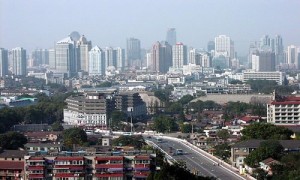Pioneering Chinese carbon exchange faces difficulties

 WUHAN -- Anyone concerned about climate change is advised to pay attention to the central Chinese city of Wuhan. As well as a population of around ten million, Wuhan is home to one of China’s first carbon exchanges, set to open for business next year. The exchange aims to put a price on carbon emitted by local firms, and the success or failure of the exchange is likely to determine the direction of China's plan to slow its rapid increase in carbon emissions, which contribute to global climate change. But employees at the Wuhan exchange say that a shortage of technical knowledge and staff threatens the project’s success.
WUHAN -- Anyone concerned about climate change is advised to pay attention to the central Chinese city of Wuhan. As well as a population of around ten million, Wuhan is home to one of China’s first carbon exchanges, set to open for business next year. The exchange aims to put a price on carbon emitted by local firms, and the success or failure of the exchange is likely to determine the direction of China's plan to slow its rapid increase in carbon emissions, which contribute to global climate change. But employees at the Wuhan exchange say that a shortage of technical knowledge and staff threatens the project’s success.
Carbon intensity targets
“This is a totally new concept for China,” Zhang Zhuotan, 30 year old assistant-secretary of Wuhan’s Carbon Reduction Association, the body responsible for setting up the Carbon Exchange, said. The association occupies a few offices in the center of Wuhan's "Optics Valley“ hi-tech zone, and a large statue resembling the Wall Street Bull stands in front of its offices. The association is funded by the government of Hubei province, of which Wuhan is the capital city. As well as the exchange in Wuhan, the Chinese government has announced plans to open six other carbon exchanges across China by 2013.
China’s total carbon emissions grew by more than ten percent in 2010, and China is now the world’s biggest emitter of carbon dioxide, according to research group the Carbon Project. Like most developing countries, China has not stated any intention to reduce the absolute amount of carbon that it emits. But China’s central government has announced a target to reduce China’s ‘Carbon Intensity,’ the amount of carbon emitted per unit of GDP by 45 percent by 2020, compared with 2005 levels.
Seven cities and provinces in China have been asked to make absolute reductions in carbon emissions by China’s national planning body, the National Reform and Development Commission, but these provincial targets have not been made public. “The targets will be one of the criteria by which government officials are assessed for promotion,” Zhang said. That means that senior government officials are more concerned about carbon emissions than previously."
The province surrounding Wuhan, Hubei, is home to a lot of heavy industry, including iron and steel making. That means that the province has more potential to reduce carbon emissions than other areas in China, according to Zhang. “Hubei has a more demanding carbon intensity reduction target than other provinces,” Zhang said.
Financial Incentives
Wuhan’s carbon exchange aims to give firms a financial incentive to reduce their carbon dioxide emissions. “Participating firms will have to make absolute reductions in emissions,” Zhang said.

The exchange's carbon trading system is designed to resemble the European Union’s Emissions Trading System, Zhang said. The exchange will decide the total amount of carbon dioxide that participating firms will be allowed to emit each year, and divide that total between the participating firms in the form of permits to emit carbon. If firms emit more than the amount specified by their amount of permits, they can buy permits from other firms who have emitted less than their quota.
When the exchange starts trading next year, between 50 and 100 Hubei-based firms will participate, Zhang said. The Department of Environmental Protection, a provincial level government agency, will decide which firms will participate in the trading scheme. “I expect they will choose firms which can make emissions reductions more easily, such as electricity firms,” Zhang said. The carbon exchange will calculate the average emissions for a firm’s sector, and then allocate permits to each firm at an amount slightly below that average. The exact amounts have yet to be calculated, Zhang said. “But firms who emit more than average will have to make absolute reductions in emissions, or pay the price of buying permits,” he said.
Past experiments with carbon trading in China have seen limited success. Three Chinese cities, Beijing, Shanghai and Tianjin set up voluntary carbon exchanges in 2009, where firms could apply to buy and sell carbon emissions credits with other firms. But these voluntary exchanges have hardly been used. The Beijing exchange has only overseen one deal, according to local media. “Because the schemes were voluntary, businesses didn’t participate,” Zhang said.
The Wuhan exchange will force companies to participate, and trade permits according to the exchange's rules, Zhang said. At the moment the exact punishment mechanism for firms which refuse to comply with the exchange’s rules has not be designed, he said. “There is no national law on carbon emissions, so the provincial government will be responsible for punishing firms,” he said. “They have the legal right to shut down a firm, or refuse to renew its license.”
Just one year
Setting up the exchange is no easy task. China lacks expertise in measuring carbon emissions accurately and objectively, according to Zhang. “In the past, the Chinese government’s way of measuring emissions wasn’t very scientific,” he said. “They mainly relied on measuring electricity and coal consumption, which misses a lot of emissions, especially from agriculture,” he said. China lacks a national standard for measuring a carbon emissions. “That makes it more likely that exchanges will assign firms with too many emissions permits, or too few,”
China is short of experts qualified to design and administer carbon exchanges, Zhang said. “We need people who know Environmental science, as well as economics,” Zhang said. “There are very few people in China with those qualifications,” he said. The exchange currently has just five members of staff, but hopes to hire at least three more people before the end of this year. Academics from several universities in Wuhan have been enlisted to help design the exchange’s trading rules, Zhang said.
The exchange hopes to receive more help from international organizations with expertise in Carbon trading, but limited funds mean that Zhang cannot afford to hire foreign staff. “The funding we received from the city government is not enough to pay for even the living expenses of foreign experts,” Zhang said.
With just one year left to set up the exchange, Zhang is worried that lack of experienced staff will lead to problems when the market opens. For instance, the exchange will open an online trading system, which Zhang worries could fall victim to hackers. “There is also scope for corruption and people pursuing private interest when administering the exchange,” he said.
As a pilot project, the success or failure of the Wuhan exchange will help determine the future of China’s carbon intensity reduction program, and the future of the world’s climate. “If we the exchange has problems when it opens next year, there's a chance that Chinese people’s trust in carbon trading could be damaged,” Zhang said.
Pictures: Google.
This post was originally published on Smartplanet.com